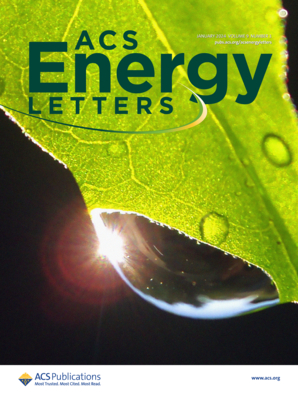通过梯度可逆合金沉积实现的中性色智能窗
IF 18.2
1区 材料科学
Q1 CHEMISTRY, PHYSICAL
引用次数: 0
摘要
基于可逆金属电沉积(RME)的智能窗户可实现较大的太阳辐射热获得系数(SHGC)调节,其中Zn-RME是一种具有高理论着色效率(CE)、成本效益和色彩中性的有趣选择。本文选择 Cu2+ 作为电解质添加剂,以降低金属电镀过程中的活化能并均匀电场分布,通过可逆合金电沉积(RAE)形成梯度 CuZn 合金纳米颗粒。与 Zn-RME 相比,CuZn-RAE 电极可在 2 分钟内实现极低的透射率(0.01%)和中性色(色度 C* = 5.8)、较大的透射率调制(82%)、快速切换时间(tc = 8 秒,tb = 18 秒)、更高的 CE 值、更高的记忆效应以及更长的循环稳定性。此外,着色的 CuZn-RAE 器件能有效阻挡红外热,使表面温度降低 7.1 °C,使用 CuZn-RAE 器件建模的中空玻璃单元(IGU)具有较大的太阳热调节能力,ΔSHGC 为 0.448,显示出动态智能窗的巨大应用潜力。本文章由计算机程序翻译,如有差异,请以英文原文为准。

Color-Neutral Smart Window Enabled by Gradient Reversible Alloy Deposition
Reversible metal electrodeposition (RME)-based smart windows can realize large solar heat gain coefficient (SHGC) modulation, where Zn-RME emerges as an intriguing option with high theoretical coloration efficiency (CE), cost effectiveness, and color neutrality. Herein, Cu2+ was selected as electrolyte additive to lower the activation energy and homogenize the electrical field distribution during metal plating, forming gradient CuZn alloy nanoparticles via reversible alloy electrodeposition (RAE). Compared to Zn-RME, the CuZn-RAE electrode can achieve extremely low transmittance (0.01%) and color neutrality (chroma C* = 5.8) within 2 min, large transmittance modulation (82%), fast switching times (tc = 8 s, tb = 18 s), higher CE, elevated memory effect, and extended cycling stability. Additionally, a tinted CuZn-RAE device can effectively block infrared heat and reduce surface temperature by 7.1 °C, and the insulating glass unit (IGU) modeled with a CuZn-RAE device offers large solar heat modulation with ΔSHGC of 0.448, showing great application potential toward dynamic smart windows.
求助全文
通过发布文献求助,成功后即可免费获取论文全文。
去求助
来源期刊

ACS Energy Letters
Energy-Renewable Energy, Sustainability and the Environment
CiteScore
31.20
自引率
5.00%
发文量
469
审稿时长
1 months
期刊介绍:
ACS Energy Letters is a monthly journal that publishes papers reporting new scientific advances in energy research. The journal focuses on topics that are of interest to scientists working in the fundamental and applied sciences. Rapid publication is a central criterion for acceptance, and the journal is known for its quick publication times, with an average of 4-6 weeks from submission to web publication in As Soon As Publishable format.
ACS Energy Letters is ranked as the number one journal in the Web of Science Electrochemistry category. It also ranks within the top 10 journals for Physical Chemistry, Energy & Fuels, and Nanoscience & Nanotechnology.
The journal offers several types of articles, including Letters, Energy Express, Perspectives, Reviews, Editorials, Viewpoints and Energy Focus. Additionally, authors have the option to submit videos that summarize or support the information presented in a Perspective or Review article, which can be highlighted on the journal's website. ACS Energy Letters is abstracted and indexed in Chemical Abstracts Service/SciFinder, EBSCO-summon, PubMed, Web of Science, Scopus and Portico.
 求助内容:
求助内容: 应助结果提醒方式:
应助结果提醒方式:


